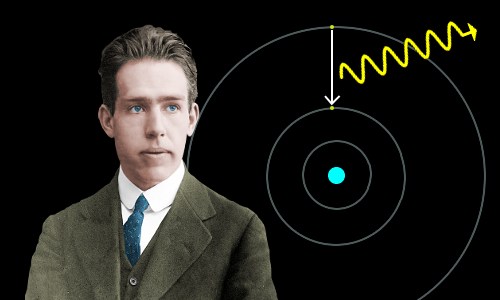

Niels Henrik David Bohr was born in Copenhagen in 1885 to Christian Bohr, a professor of physiology at the University of Copenhagen and a Nobel Prize winner, and Ellen Adler Bohr, who came from a wealthy Sephardic Jewish family prominent in Danish banking and parliamentary circles. Bohr received his doctorate from Copenhagen University in 1911 and then studied under Ernest Rutherford in the Victoria University in Manchester, England.
In 1911, Bohr visited Cambridge, where he followed the experimental work occurring in the Cavendish Labroartory under Sir J.J. Thomson's guidance and pursued his own theoretical studies. In 1912, he worked in Professor Rutherford's laboratory in Manchester. Based on Rutherford's theories, Bohr published his model of atomic structure in 1913, which is still commonly used and taught today as an educational simplification. The model introduced the theory of electrons traveling in orbits around the atom's nucleus, the chemical properties of the element being largely determined by the number of electrons in the outer orbits. Bohr also introduced the idea that an electron could drop from a higher-energy orbit to a lower one, emitting a photon (light quantum) of discrete energy. This became the basis for quantum theory.
Following in his father's footsteps, in 1916, Bohr became a professor at the University of Copenhagen. In 1920, he became director of the newly constructed "Institute of Theoretical Physics" and was awarded the Nobel Prize in Physics in 1922 "for his services in the investigation of the structure of atoms and of the radiation emanating from them."
After 1930, Bohr's activities in his Institute were focused on research on the constitution of the atomic nuclei and of their transmutations and disintegrations. He also contributed to the clarification of the problems encountered in quantum physics, which is discussed in several essays written between 1933 and 1962.
In 1943, shortly before he was to be arrested by the German police, Bohr escaped to Sweden and then traveled to London. He worked at Los Alamos on the Manhattan Project, where he was allegedly known by the assumed name of Nicholas Baker for security reasons. However, his role in the project was minor, as he was seen as a knowledgeable consultant. After the war, he returned to Copenhagen, advocating for a peaceful use of nuclear energy. In 1955 he organized the first Atoms for Peace Conference in Geneva, Switzerland.
Bohr and his wife Margrethe had six children, one of whom,
Aage Niels Bohr, became a very successful physicist and also won a Nobel Prize.
Bohr died in Copenhagen in 1962.
The element bohrium is named in his honor.
No comments:
Post a Comment